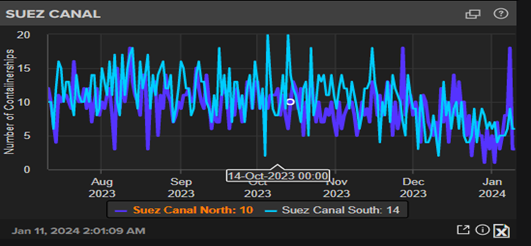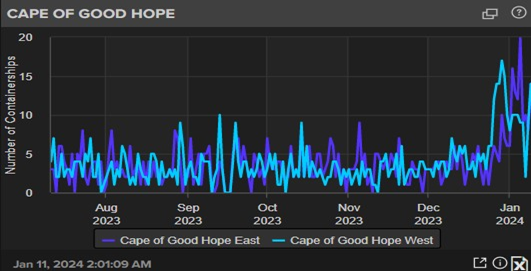
Red Sea, a vital maritime choke point
Strategically positioned
The Red Sea – an inlet of the Indian Ocean – lies between Africa and the Arabian Peninsula. It is strategically positioned – to its north lie the Gulf of Suez (connecting it to the Mediterranean Sea via the Suez Canal) and the Gulf of Aqaba. To the south, it is connected to the Indian Ocean by the Gulf of Aden and Bab-el-Mandeb. This vital Red Sea shipping lane links Europe to Asia via the Suez Canal.
Whilst this channel is central to much international shipping and trade, it can also become a significant maritime choke point under certain conditions – as was the case in March 2021, when the containership ‘Ever Given’ was stuck aground in the canal for six days, blocking maritime trade.
Monitoring traffic changes
The deterioration of maritime security in the Red Sea in the wake of recent Houthi attacks on commercial shipping has meant that it is now crucial to monitor the flow of traffic through this important area.
The conflict has already had a substantial impact on containership transits though the Suez Canal: these decreased by 26% in December 2023. In comparison, the volume of oil tankers transiting the canal fell by 7%, whilst dry bulker traffic saw a minimal 3% drop over the same period.

Knock-on effects
These changes in the volumes of commercial ships transiting the Red Sea/Suez Canal are having a knock-on effect elsewhere. As containerships, oil tankers and other vessels avoid the Red Sea route, traffic is increasing around the Cape of Good Hope. This, in turn, has been fuelling freight rate rises, as the longer distances travelled have led to increased fuel consumption – not to mention rising carbon emissions.

Rate rises on this key lane are expected to help liner companies’ profits to some extent – but this will depend on how long the current situation persists, and will further be influenced by various multinational navies, including the US Navy, which may act to prevent further attacks on ships and precipitate a freight rates correction.
As always, it will remain essential to monitor changes closely, as any improvement in or deterioration of the current situation could have a substantial impact on the maritime industry.
Xeneta Shipping Index: Far East to North Europe

Request access to Workspace today!
By submitting this form, you agree to your personal data being shared within the London Stock Exchange Group of companies (LSEG) for the purpose of receiving communications via post, phone and electronic means from LSEG about event, resources, products, and/or services.
For more information on how LSEG uses your data, see our Privacy Statement.
You can adjust your preferences at any time through the preference link in any electronic communication that you receive from us.For more information on how LSEG uses your data, see our Privacy Statement.
You can adjust your preferences at any time through the preference link in any electronic communication that you receive from us.
For more information on how LSEG uses your data, see our Privacy Statement.
You can adjust your preferences at any time through the preference link in any electronic communication that you receive from us.For more information on how LSEG uses your data, see our Privacy Statement.
You can adjust your preferences at any time through the preference link in any electronic communication that you receive from us.


